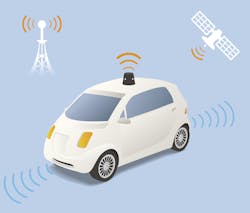Recently, I bought a new SUV. Weeks later I am still learning to use it. It is no secret that the electronic content of cars and trucks has increased dramatically over the years. The electronics has added new safety and convenience features, but it has also increased driving distraction and steepened the learning curve. I am both loving and hating the electronic content of my new vehicle and enduring the frustration of learning how it works and how to use it. But I’m getting there.
I hadn’t bought a new car in six years. In that time, lots of new electronic goodies have become standard. In fact, younger buyers are expecting the electronics to just be there. What is becoming clear to me is that the new electronic features are useful and helpful but they do introduce a complexity that did not exist before. Take the radio as an example. In older cars, to hear a local AM station for traffic news, you turned the radio on, selected AM and tuned to the station. In my new car, it takes four touchscreen menu selections and knowledge of a new set of icons to get to a station. Tuning is additional with the touchscreen or a knob. It is possible to set up a Favorites station to eliminate the tuning step. Almost every other function is like that.
Another example is the headlights. In my older cars, the headlights had a single switch to turn on the headlights and/or parking/running lights. In my new vehicle there are multiple rotary switches on a stalk. The headlight switch has five positions—one for off, and the others for controlling the high beams either manually or automatically. Another position gives AUTO control where the car determines when to turn the lights on or off. Yet another switch turns the fog lights off or on. I had to read the manual to figure all of this out. The headlights are all LED and super-bright. They also rotate to the right or left when you are turning to better light the way into the turn (nice on a dark road). There are interesting daylight running lights, too.
Then there is all of the wireless. The remote keyless entry uses an RF link to open and lock the doors. The key fob also links wirelessly to an internal ignition switch transceiver that enables the start/stop button. Next are the Bluetooth connections for hands-free cell phone use and connecting the music on your phone to the car’s audio system. And don’t forget the wireless tire pressure sensors and monitor. My vehicle also has three 315-MHz ISM band transmitters to use for remote control of garage doors, gates, and other entrances. You first have to program each transmitter with the garage door or gate remote unit. It works quite well.
The entertainment system may be the most complex I have ever encountered. It uses a 7-in. color touchscreen and a big control knob on the shifter console. This arrangement seems to be popular in many other vehicles, as well. There are lots of new icons to learn and menus and sub-menus galore. The touchscreen is disabled while you are driving to prevent distraction, in which case you resort to the control knob to make menu selections. Radio selections include AM, FM, HD, and SiriusXM satellite with its 184 channels. (HD is the U.S. digital system that simultaneously rebroadcasts AM or FM content digitally via an RF overlay of OFDM on the same frequency.)
In addition, I can select the CD player or Bluetooth music from whatever source. Pandora and aha are also available. It has taken me several playing-around sessions to figure all this out. I still don't like to do it while driving. I haven't tried out the GPS navigation system yet, but there is another learning session or two. All of this would be much easier to use if the voice response system would recognize my voice. Maybe I am speaking a foreign language.
As for the safety features, the new car has multiple radars and lasers and various sensors for blind spot, lane departure, and back-up warning notifications. There is also automatic rear braking and self-adjusting cruise control with auto braking. The all-wheel-drive system has traction control. I have yet to experience all this stuff but the backup camera is great.
I think all the new electronic features are okay, but they are an example of how complex things have become. Designers need to be careful to not over-design. Furthermore, designers should employ consumer focus groups to use what they designed. Make it easier, not harder to use. I know you embedded programmers are having fun with this as you ponder what else to pile on.
Anyway, I am still learning. I have yet to figure out how to set the dashboard clock, but I am sure my 2-in. thick, 400+ page user’s manual can show me how in a dozen easy steps.
Self-driving cars are next. You have to wonder if they will be easier to learn and use since no driving is involved. Or will they be harder to use since you have to tell the car where to go and how to find a parking space in the mall parking garage? Lots of fun stuff to look forward to. Isn't technological progress great? Sometimes I just wish for a '60s muscle car with a good AM radio.
Looking for parts? Go to SourceESB.
About the Author

Lou Frenzel Blog
Communications Technology
Click here to find more of Lou's articles on Electronic Design.

